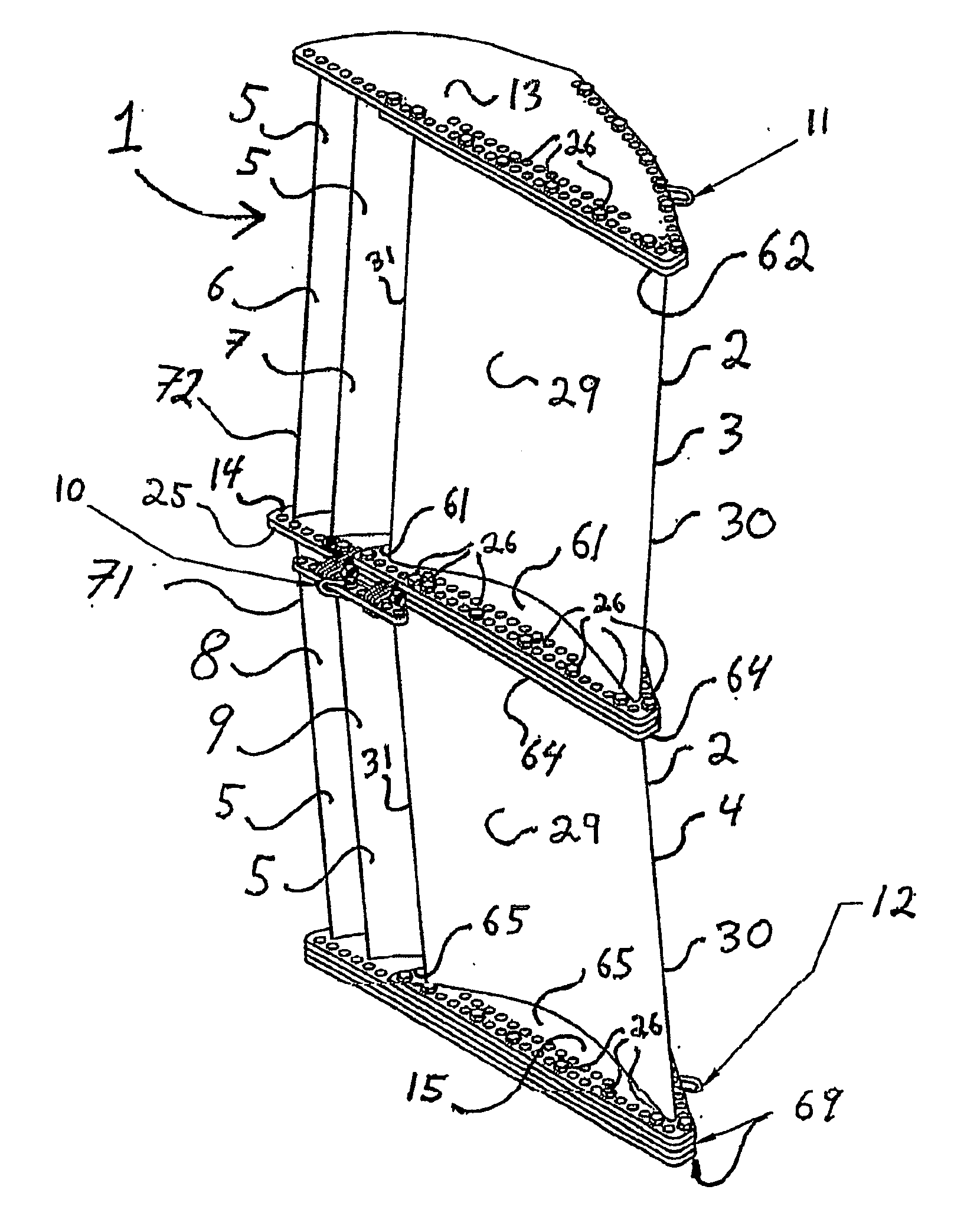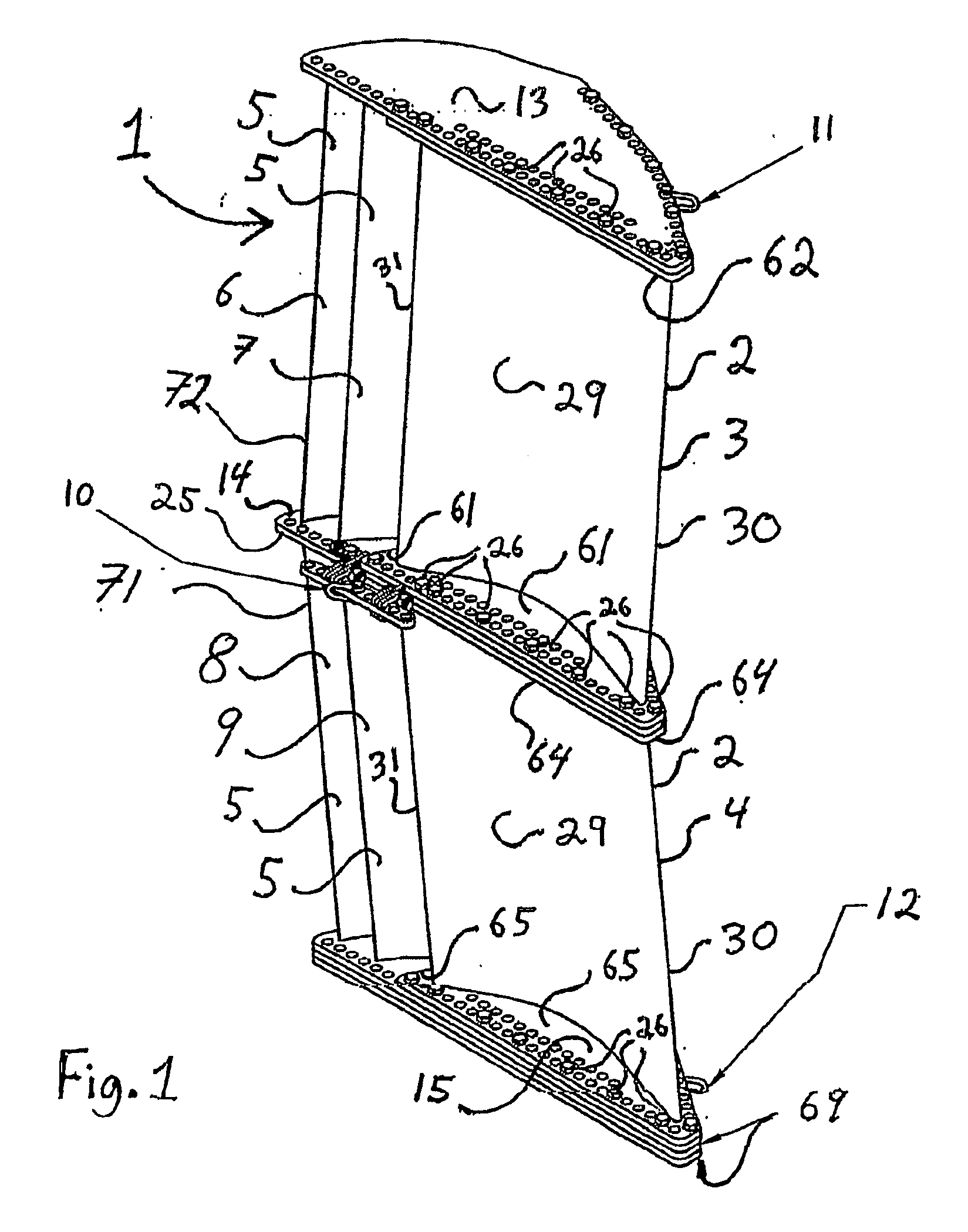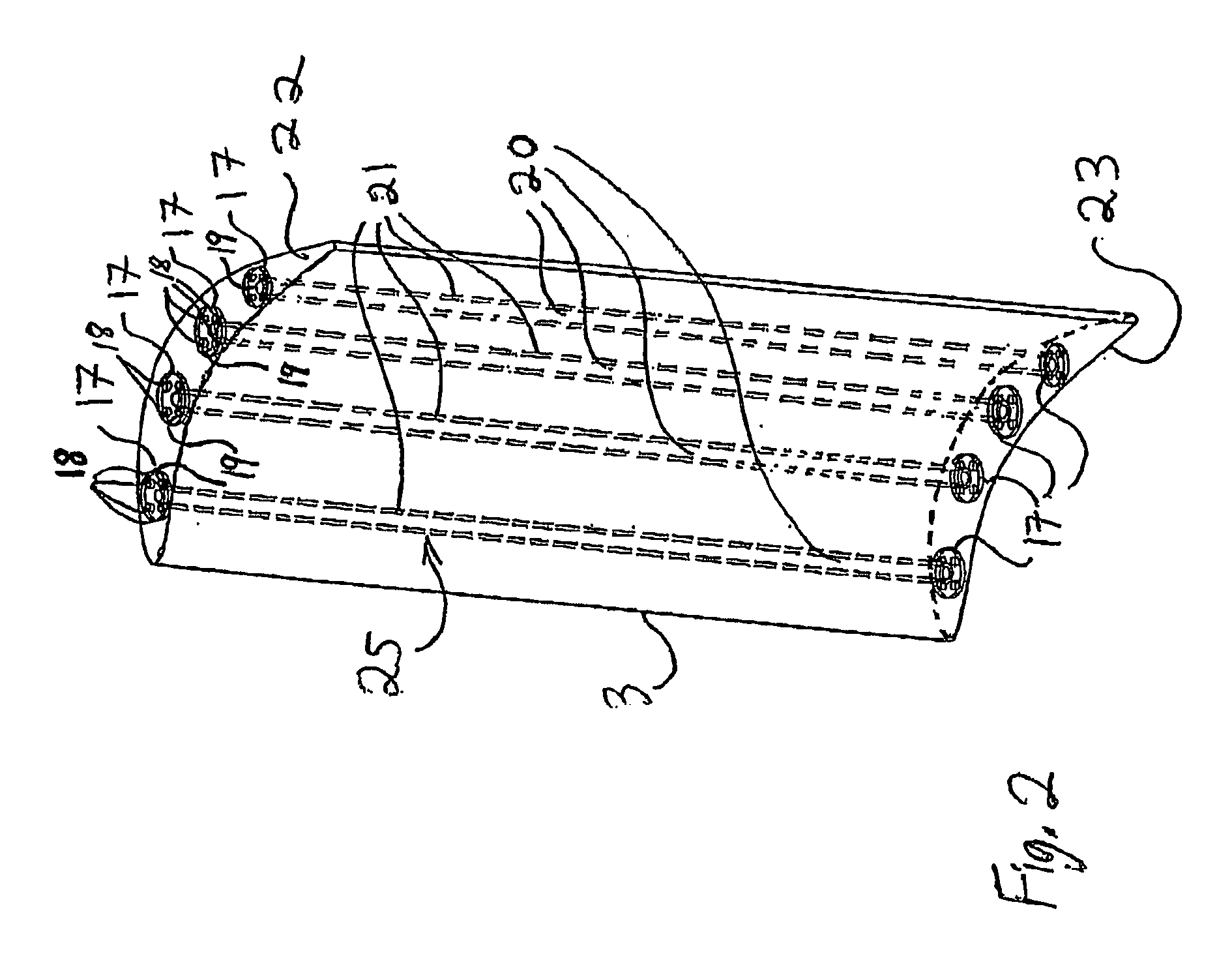Modern trawl fisheries are complicated by an increase in operating costs due primarily to increasingly expensive fuel costs affecting both the catch of as well as the transportation to market of fish and value added fish product.
Problematically, known trawl door designs are not optimally economical at shallow depths or high speed
trawling operations, nor can they be optimally interchanged between
operational requirements for high opening trawls and wide body trawls.
For another reason, due to the fact that only such relatively short lengths of
wire rope main
towing warps are able to be paid out during high speed shallow depth
trawling operations, a given set of trawl doors is not able to provide the requisite horizontal distance (spread) between
towing points on the trawl for optimal trawl spread and opening, as the
towing warps are too short to permit such distance.
Problematically, any particular trawl door only exhibits optimum hydrodynamic efficiency at a certain
angle of attack, just as any particular airfoil only exhibits optimum aerodynamic efficiency at a certain
angle of attack of its chord to the
airflow, and thus varying the
angle of attack of a certain trawl door in order to regulate spread and
water resistance forces necessarily means the trawl doors and thus the trawling vessel must operate at a reduced level of efficiency.
In order to overcome this problem, some pelagic trawlers use two varying sizes and even different designs of trawl doors, despite the increased costs and inconvenience associated with such practice.
The second door pair may be smaller in size, and thus lighter weight in water as well as having less resistance in water, and is thus able to be operated with a high opening trawl at moderate depths and at higher speeds and higher elevations in the
water column, although in such case it is not able to provide optimal spread for the towing vessel due to the smaller size of the trawl door.
Currently, no single trawl door construction exists that is both light weight in water, optimally efficient both at shallow depth and high speed trawling operations as well as at deeper depth trawling operations, nor optimally useful both at spreading high opening pelagic trawls as well as spreading wide body pelagic trawls.
However, teachings of U.S. Pat. No. 4,180,935 that pertain to the shape of main deflector bodies used in trawl doors essentially have not been found useful by those in the art and appear not to be used by the industry.
However, while embodiments of trawl doors as shown in U.S. Pat. No. 4,640,037 have not been found sufficiently efficient so as to be preferred for pelagic fisheries and essentially are not in use in modern pelagic trawl
fishing operations, certain embodiments of trawl doors as disclosed in this patent are used in bottom trawl fishing.
However, despite the terminology of “wing shaped” widely and generally used by the trawl door industry in referenced to conventional trawl door design, as already mentioned above little or no substantial
engineering similarity exists between conventional trawl door design and conventional
airplane wing design.
For one reason, one of the complications impeding successful application of airfoil designs to trawl door design has been that modern trawling speeds of approximately three to seven knots are considered by those skilled in the art to apply and correlate in modeling to air speeds approaching supersonic, where thinner wings having shapes proven not efficacious for trawl doors are applicable.
Thus, attempts at employing efficient airfoil designs in trawl doors have not been successful.
Furthermore, employing maximally efficient Low-Speed (and
high lift) airfoil designs into trawl doors is contrary to widely held beliefs in the industry regarding
engineering principles cross-applicable between trawl doors and airfoils, with such widely held beliefs in the art mandating that modern trawling speeds of 3.0 to 7.0 knots correlate to high air speeds, even speeds approaching supersonic.
A difficulty presented by the known art is that the most efficient of trawl doors known in the art are rather expensive to manufacture, and thus have not gained as wide use as less expensive alternatives.
Problematically, using only
metal to construct such a thick trawl door of sufficient strength and
impact tolerance, even with a hollow metallic shell over a strength and tension bearing frame, results in a trawl door so heavy that it is anchor-like and practically useless for the majority of pelagic fishing vessel requirements.
The
high density foam is unusually expensive and the manufacture processes used to make such trawl doors are unusually expensive.
The manufacture process employed utilizes a large amount of costly
high density foam, more steel than alternatively inner trawl doors, and a great deal of manpower and
machine time.
Thus the high cost of such trawl doors.
While the most efficient of known trawl doors are so expensive to manufacture, nonetheless their efficiency at shallow depths is only marginally greater than less expensive, heavier trawl door constructions.
Thus, the vast majority of fishing vessels acquire and utilize less efficient trawl doors that are less expensive to manufacture as the thicknesses (widths) of the such trawl doors' main deflector bodies are rather slight.
As evidenced from the above description of the state of the known art, the main difficulty in constructing trawl doors having the most efficient known shape for the main deflector is that due to the rather thick width of the main deflector, much steel must be used to create a shell.
The shell either must form a cavity which is in
open communication to the
water environment to permit sea water to enter and exit the shell so as to neutralize pressures (i.e. It is not a
closed space as the shell cannot tolerate
high pressure at fishing depths, or else it would be far too heavy and expensive to create), which construction employs much steel and makes the trawl doors too heavy to be widely useful.
Otherwise, if
buoyancy is desired, much expensive
high density foam must be used to occupy the inner void spaces within the steel shell, which construction and contemporaneous manufacture requirements makes the manufacture of the trawl doors too expensive to be widely affordable.
However, despite the expectation that the synthetic formed trawl doors would tolerate field operations, such trawl doors rather quickly experienced
structural failure, both in cold as well as in moderate temperatures, and even when only minimal shocks were experienced, despite the fact that the thickness and other dimensions of the synthetic plating used in place of the metallic plating were calculated and expected to have sufficient strength and durability to survive the rigors of
field conditions.
Thus, despite application of the very same materials widely and generally used in
impact absorbing marine structures, such synthetic trawl doors failed in operation, with no apparent explanation for such.
Thus, attempts at using synthetics in the exterior shells of trawl doors, or as other
impact receiving and bearing structures as well as in tensile force bearing structures of trawl doors have been unsuccessful.
Today, the use of synthetic structures in trawl doors either for plating or exterior shells, or as impact or tension bearing structures is considered unfeasible by the industry.
Therefore, the manufacture of trawl doors continues to require metallic plating and frames forming the primary impact bearing and tension bearing structures of trawl doors, and thus lighter than weight, thick-bodied trawl doors continue to be much more expensive while only marginally more efficient than less expensive alternatives, and thus have not been adopted for use by the vast majority of fishing vessels.
Thus also, it is apparent that attempted solutions to the problems in the art as described supra, while having improved the state of the art from what existed before implementation of such attempted solutions, have not fully solved the problems in the field, and have only permitted the current state of the art, with its concurrent limitations, as described above.
 Login to View More
Login to View More 


